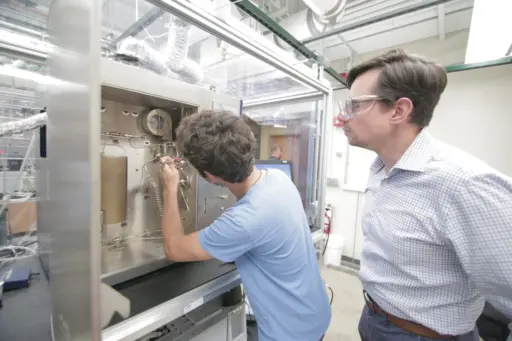Between growing up in Belgium, a trilingual country with multiple ethnic communities, receiving dual training in chemistry and chemical engineering, and holding faculty positions in both Europe and the United States, Ive Hermans is used to straddling two (or more) worlds. That helps him relate to the distinct mindsets of students who major in either of his own two disciplines.
“Most chemical engineering students are very good at performing an experiment, which may include writing programming code to extract information, or simulating chemical reactions,” says Hermans, the John and Dorothy Vozza Professor of chemistry at the University of Wisconsin-Madison. “But chemistry students may be better at interpreting the experimental data on the molecular level.”
Hermans enjoys bringing together these different skills and perspectives in a research team charged with doing something new and creative—which is why many of his papers include students and faculty members from two academic homes: the College of Letters and Science, which includes the Department of Chemistry, and the College of Engineering, where the Department of Chemical and Biological Engineering is housed.
Hermans himself was a joint hire by these two departments. He moved to Madison in January 2014 and continues to divide research and teaching responsibilities evenly between his two academic homes.
He also tries to bridge the worlds of industry and academia, and is perhaps uniquely qualified to do so, having earned a post-graduate business degree “on the side” while working on his PhD. A prime example is a class for budding chemists and engineers called Industrial Chemistry and Business Fundamentals, which he co-teaches with William Banholzer, former CTO of the Dow Chemical Company who is now a research professor of chemical and biological engineering.
“Students may join a chemical company with a PhD in polymer engineering, but they don’t know how to make a garbage bag,” Hermans says. “The practical knowledge of how stuff is made is often lost in academia, but if you want to devise a new way of making something, you need to know the benchmark you have to exceed.”
Much of Hermans’s research—for which he received UW-Madison’s Vilas Faculty Mid-Career Investigator Award in June 2017—involves designing more sustainable chemical reactions that generate less waste, consume less energy, or produce fewer greenhouse gas emissions, while still meeting consumer demands for the everyday products that rely on these reactions.
A perfect example is a paper published in February 2017 in the journal Green Chemistry. Its first author, graduate student Samuel Burt, is mentored by Hermans. Other student authors are co-advised with two of his frequent collaborators: Harvey D. Spangler Professor George Huber and Ernest Micek Distinguished Chair James Dumesic, both in the Department of Chemical and Biological Engineering.
 Ive Hermans and Juan Venegas, a chemical and biological engineering graduate student, install a gas phase reactor for one of the lab’s latest projects: converting propane, found in natural gas, into a building block for plastic consumer products.
Ive Hermans and Juan Venegas, a chemical and biological engineering graduate student, install a gas phase reactor for one of the lab’s latest projects: converting propane, found in natural gas, into a building block for plastic consumer products.
The goal of the project was to produce a specialty chemical called 1,6-hexanediol from cellulosic (nonedible) biomass in a more straightforward and sustainable way than currently implemented. The chemical is a basic building block for many different kinds of plastics and is traditionally made from petroleum in a complex reaction involving many different steps.
“Rather than having biomass compete with fossil fuels, we want to focus on products that are difficult to make in any other way,” Hermans explains. “This is just one of several tricks in our toolbox: to ask if there are other raw materials that can be turned into a highly desirable building block in a cost-effective and fairly simple reaction that produces fewer emissions.”
Another trick—applied in a December 2016 Science paper that was also co-authored by students from Hermans’ two departments—is to find a new catalyst, a chemical designed to speed up a reaction of interest with minimal changes to its own structure.
Hermans says both papers illustrate the benefits of being affiliated with more than one department: access to a greater number of students and the opportunity to collaborate with world-class faculty who contribute a wide range of expertise to joint research projects.
During the more than three years Hermans has lived in the United States, he has noticed a fundamental difference in how his colleagues react to new ideas. “In Europe, people will often focus on why a new idea will not work,” he says. “In the U.S., people are more open-minded and enthusiastic about trying new things—even though that sometimes means pursuing an unrealistic goal.”
Being open-minded is one of the values Hermans hopes to instill in his students. Others include the ability to speak more than one scientific language—that of chemistry and chemical engineering—and to approach a complex problem that may initially seem unmanageable with confidence. He says most big problems can be broken down into smaller sub-problems, each of which can then be solved with the scientific method. If that is unsuccessful, it is just as important to recognize the right time to leave a project as it is to identify a new one.
But his most important advice for students, especially those who are just beginning their research careers, is this: Don’t be afraid of failure.
“Students with a perfect GPA may not have learned yet how to recover from disappointment, so they are sometimes afraid to highlight whatever aspect of an experiment did not work as expected,” he notes. “But chemical experiments are almost never perfect. The unexpected results you observe along the path of systematic inquiry are often the much more interesting observations that merit deeper investigation.”